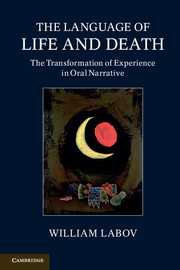Book contents
- Frontmatter
- Contents
- Preface
- Acknowledgments
- 1 Introduction to the language of life and death
- 2 Narrative analysis
- 3 The escalation of violence
- 4 Confrontations with death
- 5 Premonitions and communication with the dead
- 6 Margie Knott: “Her confrontation with the neighbors”
- 7 Gloria Stein: “They stoned the house”
- 8 Rose Norman: “The death of her younger sister”
- 9 Mary Costa: “The death of her youngest daughter”
- 10 Cache County
- 11 The vernacular origin of epic style
- 12 Historians' use of narrative
- 13 Thomas Babington Macaulay: “The death of Monmouth”
- 14 S. T. Bindoff: “The death of Elizabeth”
- 15 2 Samuel: “The death of Absalom”
- 16 The narrative view of death and life
- References
- Index
6 - Margie Knott: “Her confrontation with the neighbors”
Published online by Cambridge University Press: 05 June 2013
- Frontmatter
- Contents
- Preface
- Acknowledgments
- 1 Introduction to the language of life and death
- 2 Narrative analysis
- 3 The escalation of violence
- 4 Confrontations with death
- 5 Premonitions and communication with the dead
- 6 Margie Knott: “Her confrontation with the neighbors”
- 7 Gloria Stein: “They stoned the house”
- 8 Rose Norman: “The death of her younger sister”
- 9 Mary Costa: “The death of her youngest daughter”
- 10 Cache County
- 11 The vernacular origin of epic style
- 12 Historians' use of narrative
- 13 Thomas Babington Macaulay: “The death of Monmouth”
- 14 S. T. Bindoff: “The death of Elizabeth”
- 15 2 Samuel: “The death of Absalom”
- 16 The narrative view of death and life
- References
- Index
Summary
Up to this point, we have been dealing with narratives that are remarkable for their brevity as well as their interest, and their capacity to transfer the experience of the narrator to the listener. A number of them could be best seen as consisting of several episodes, defined by a shift of orientation to a different time and/or place. We turn now to spoken texts that are episodic in principle. Each of them consists of a series of well-formed narratives united by a single initiating factor – an event with dynamic consequences or an unstable situation. This initiating factor generates the most reportable events that in turn generate the construction of the individual episodes. It is responsible for instability in the orienting situation for each episode described by the narrator. The final episode centers on the resolution of this common problem.
These are epic narratives in several senses. First, they cover an epic sweep of time and place. Second, the problem confronted is not an ordinary problem. As in traditional epics, the protagonist is thrust into a struggle against what appear to be hopeless odds. Third, the protagonist is not an ordinary person. Through a series of displays of extraordinary abilities, the protagonist ultimately resolves the problem.
- Type
- Chapter
- Information
- The Language of Life and DeathThe Transformation of Experience in Oral Narrative, pp. 107 - 122Publisher: Cambridge University PressPrint publication year: 2013



